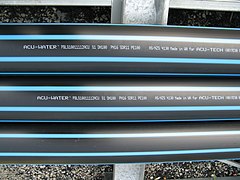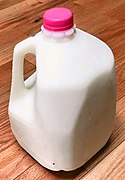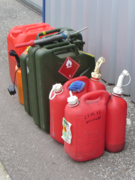High-density polyethylene

High-density polyethylene (HDPE) or polyethylene high-density (PEHD) is a
In 2007, the global HDPE market reached a volume of more than 30 million tons.[2]
Properties
| Density | 961 kg/m3 |
|---|---|
| Melting point | 131.8 °C. |
| Temperature of crystallization | 121.9 °C. |
| Latent heat of fusion | 188.6 kJ/kg. |
Thermal conductivity
|
0.54 W/m.°C. at °C. |
| Specific heat capacity | 1331 to 2400 J/kg-K |
| Specific heat (solid) | 2.9 kJ/kg. °C. |
| Crystallinity | 61% |
HDPE is known for its high strength-to-density ratio.
HDPE is resistant to many different solvents, and is exceptionally challenging to glue; joints are typically made by welding.
The physical properties of HDPE can vary depending on the molding process that is used to manufacture a specific sample; to some degree, a determining factor is the international standardized testing methods employed to identify these properties for a specific process. For example, in rotational molding, to identify the environmental stress crack resistance of a sample, the notched constant tensile load test (NCTL) is put to use.[8]
Owing to these desirable properties, pipes constructed out of HDPE are ideally applicable for drinking water[9] and waste water (storm and sewage).[10]
Applications
-
HDPE fibers can be spun into rope
-
Disposable suits; nonwoven HDPE fabric
-
Plastic mailing envelopes
-
Flexible HDPE pipes
-
Corrugated HDPE pipe installation in storm drain project in Mexico
-
The monobloc chair
-
Bottle crates
-
Toys and playground equipment
-
Clear plastic bags (shown) are made of LDPE; blown-film shopping bags with handles are now made of HDPE
-
HDPE is used to make sturdy bottles that resist oils. Transparent bottles are usually made of other plastics, such as polyethylene terephthalate
-
Milk jug
-
HDPE jerrycans resist softening and swelling from aromatic components of fuels
-
Roller on HDPE construction entrance mat
HDPE has a wide variety of applications; for applications that fall within the properties of other polymers, the choice to use HDPE is usually economic:
- 3D printerfilament
- Arena board (puck board)[11]
- Backpacking frames
- Ballistic plates
- Banners
- Bottle caps
- Boats
- Chemical containers
- Chemical-resistant piping
- Coax cableinner insulator
- Conduit protector for electrical or communications cables
- Corrosion protection for steel pipelines
- Electrical and plumbing boxes
- Far-IR lenses
- Fireworks
- Folding chairs and tables
- Food storage containers
- Fuel tanks for vehicles
- Geomembrane for hydraulic applications (such as canals and bank reinforcements)
- Geothermal heat transfer piping systems
- Heat-resistant firework mortars
- Housewrap (Tyvek)
- Hovercraft: The material is too heavy and dense for such craft but is still used occasionally
- Ionizing radiation shield[12][13]
- Laundry detergent jugs
- Lasts for shoes
- Microwave telescope windows
- Milk jugs
- Natural gas distribution pipe systems[14]
- Piping for fluid, slurry and gas purposes
- Plastic bags
- Plastic bottles suitable both for recycling or re-use
- Plastic surgery (skeletal and facial reconstruction)[15]
- Potable water mains[9]
- Root barrier
- Shampoo bottles
- Sewage mains[10]
- Snowboard rails and boxes
- Stone paper
- Storage sheds
- Swimming pool installation
- Trackout control mats
- Telecom ducts[16]
- Water pipes for domestic water supply and agricultural processes[9]
- Wood plastic composites (utilizing recycled polymers)

HDPE is also used for
HDPE is preferred by the
Milk bottles, jugs, and other hollow goods manufactured through blow molding are the most important application area for HDPE, accounting for one-third of worldwide production, or more than 8 million tonnes.
Above all, China, where beverage bottles made from HDPE were first imported in 2005, is a growing market for rigid HDPE packaging, as a result of its improving standard of living. In India and other highly populated, emerging nations, infrastructure expansion includes the deployment of pipes and cable insulation made from HDPE.[2] The material has benefited from discussions about possible health and environmental problems caused by PVC and polycarbonate associated bisphenol A (BPA), as well as its advantages over glass, metal, and cardboard.
Production
Industrial production of HDPE from ethylene happens through either Ziegler-Natta polymerization or the Phillips slurry process. The Ziegler-Natta method uses a combination of catalysts, including titanium tetrachloride, in contact with gaseous ethylene to precipitate high-density polyethylene.[17] In a similar way, the Phillips slurry process uses silica-based catalysts in contact with a fast-moving hydrocarbon and polyethylene slurry to precipitate high density polyethylene.[18]
Processing will determine the properties of the HDPE. The method used to synthesize the HDPE is crucial because the micro structure of the HDPE will vary. The Phillips Slurry process results in HDPE with less branching and more precise molecular weights than the Ziegler process, but the Ziegler process provides greater flexibility in the type of polyethylene produced.[18]
The molecular weight of HDPE refers to the length of the polyethylene chains, and helps determine properties such as flexibility, yield strength, and melt temperature. After the precipitate is formed, the temperature, pressure, and cooling time during processing will dictate the degree of crystallinity, with a higher degree of crystallinity resulting in greater rigidity and chemical resistance.[19] Depending on the application, the method and processing steps can be adjusted for an ideal result.
Once the HDPE has been synthesized, it is ready to be used in commercial products. Industrial production methods for HDPE products include injection molding for complex shapes such as toys. Extrusion molding is used for constant-profile products such as pipes and films. Blow molding is intended for hollow products, specifically bottles and plastic bags. Rotational molding is used for large, seamless parts such as chemical drums and kayaks.[19] The method used during processing depends on the product requirements, with each having benefits for a given application.
See also
- Cross-linked polyethylene (PEX)
- HDPE pipe (HDPE)
- Low-density polyethylene (LDPE)
- Linear low-density polyethylene (LLDPE)
- Medium-density polyethylene (MDPE)
- Phillips Disaster
- Plastic recycling
- Polyethylene (PE)
- Resin identification code
- Stretch wrap
- Ultra-high-molecular-weight polyethylene (UHMWPE)
References
- ^ Pipe materials. level.org.nz
- ^ a b "Market Study: Polyethylene HDPE". Ceresana Research.
- ISSN 0141-3910.
- ^ Thermoforming HDPE Archived 2012-02-05 at the Wayback Machine. Dermnet.org.nz
- ^ Typical Properties of Polyethylene (PE). Ides.com. Retrieved on 2011-12-30.
- )
- ^ Compare Materials: HDPE and LDPE. Makeitfrom.com. Retrieved on 2011-12-30.
- ^ www.rotomolding.org. Retrieved 2016-4-20.
- ^ a b c "Acu-Water | HDPE Blueline Water Pipe". Acu-Tech Piping Systems.
- ^ a b "Acu-Sewer Pressure Pipe for Sewer Mains". Acu-Tech Piping Systems.
- ^ "Puck Board (HDPE Sheets)". Professional Plastics. Retrieved 24 December 2018.
- ^ AstroRad. European Space Agency. 25 January 2019.
- ^ Gaza, Razvan (14 July 2018). "International Science Aboard Orion EM-1: The Matroshka AstroRad Radiation Experiment (MARE) Payload" (PDF). nasa.gov. Retrieved 27 August 2019.
- ^ "Acu-Gas Yellow High Pressure HDPE Pipe". Acu-Tech Piping Systems.
- ^ Dermnet.org.nz. Dermnet.org.nz (2011-07-01). Retrieved on 2011-12-30.
- ^ "Acu-Comms White Communications Conduit". Acu-Tech Piping Systems.
- ^ "Ziegler-Natta catalyst | Polymerization, Olefins, Alkylaluminums | Britannica". www.britannica.com. Retrieved 2023-11-16.
- ^ ISSN 0007-1641.
- ^ ISSN 0001-9240.
















